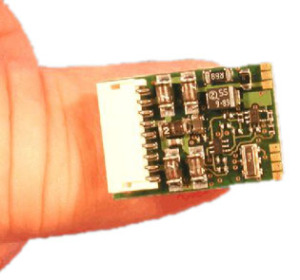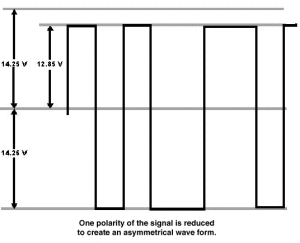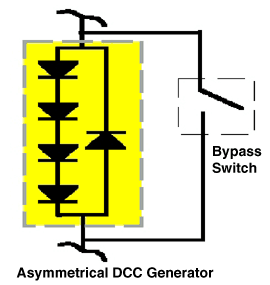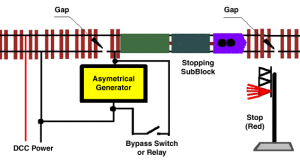Lenz Asymmetrical DCC and ABC
by Don Fiehmann
Don Fiehmann drafted this to show us how to use Asymmetrical DCC for: stopping in front of a red signal, automatic back and forth operation and protecting crossings or turnouts.
This is a closer look at some of the new features of the Gold Series decoder made by Lenz. The source of this information comes from the Lenz manuals, the Internet and some real life testing.
The Lenz Corporation
The Gold series decoder from Lenz incorporates a couple of new features that needed a closer investigation. The new features further advance the abilities to automate train operation. These features can be used as an aid in layout automation and will also work for a display layout that runs with minimum personnel. The features are Constant Stopping Distance, Automatic Brake Control (ABC) and Asymmetrical DCC. Here is an explanation of each of these features, then a look at how these all work together. All of these features are controlled by bits in CVs and can be on or off.
|
Thumbnail size decoder with great features.
|
Constant Stopping Distance. This feature needs to be turned on by setting Bit 1 in CV-51. The length of stop is controlled by the value in CV-52. This feature is activated by setting the speed step 00. Once activated the function continues until it is finished and the engine stops at the same distance regardless of engine speed. My tests show that this works remarkable well. Fast or slow the stopping distance was the same!
ABC or Automatic Brake Control works in conjunction with Asymmetrical DCC. So not to confuse you (and me too!) lets go over this operation slowly. First Asymmetrical DCC is a way to trigger Automatic Brake Control in the decoder. This gives the ability to activate the stopping feature automatically at a section of track with Asymmetrical DCC. When ABC is triggered it can turn on Constant Stopping Distance. Direction of control is also controlled by a bit in a CV. This would let a train pass in one direction without stopping and still stop in the other direction. There is also a CV that sets the speed when approaching a restrictive (yellow) signal. With the ability to slow for a yellow signal or stop for a red signal trains could be operated automatically.
The Asymmetrical DCC signal is generated by offsetting one phase of the DCC signal. This signal can then trigger the Automatic Brake Control in a Gold series decoder. This causes the engine to stop at the distance set up in the Constant Stopping Distance feature. Lenz is releasing three Asymmetrical DCC generators. The BM1 is a simple 5 diode unit. The BM2 can remotely stop or set restrictive speeds. It will also control Push-Pull or multi unit trains. The most advanced BM3 has full block occupancy detection and control and can be operated with a remote signal. The BM2 and BM3 have not been released.
Another Gold series ability is Push-Pull operation. This lets you setup a section of track for automatic two ended train operation. A commuter train could shuttle back and forth between intermediate stops. This could also be used for a trolley line. Intermediate stops can be setup along with timed stops at each end of the run. The stop time can be set from 1 to 255 seconds. Again these features are turned on with values in CVs or left off.
Running Tests
Constant Braking Distance For a test I set up a passenger train and set the stopping distance so the last car would stop at the location that I hit the brake (Speed Step 00). Fast or slow, when I hit the brake the train would roll by and stop at the same place. At slow speeds the train would continue and come to a very slow prototypical stop. At high speed the train would roll by and then come to a quick stop at the same spot. Speed changes other than zero that triggers this feature worked normally.
Asymmetrical DCC and ABC These two feature allow stopping at a section of track. The section could be in front of a station and have a passenger train automatically slow down and stop at the station. Another use would be to slow and/or stop a train at a block signal or a rail crossing. The Lenz information states that a simple generator can be made with 5 diodes, 4 in one direction and 1 in the other direction (See drawing). These diodes are connected in series with the track power on a section of track that will trigger the ABC feature. Each silicon diode has a voltage drop of about 0.7 volts. So the 4 diodes would be a drop of (0.7X4) 2.8 volts.
| The asymmetrical generator is connected between the DCC power and a subblock. The sub-block must be longer than the longest train plus the stopping distance. The sub-block can be in front of a station, block signal or rail crossing. |
I built the 5 diode generator and installed it in a section of track in front the passenger station. My passenger train would come to the section of track powered through the diodes and then automatically slow down and stop just like it did when the constant stopping distance was activated. The train stopped right in front of the station. The next problem is how do you get the train running again. That turned out to be simple. Just short out the diode circuit and the train slowly started up and left the station. A toggle switch was install on the control panel to short out the diode circuit. I found that tapping F3 (Switching Speed) would also start the train. I ran other locomotives through the section of track and there was no change in speed. Only a locomotive with ABC turned on would stop.
The Asymmetrical DCC function would work for a section of track in front of a signal. When the signal is red the circuit would stop the train and when clear a relay could bypass the circuit and the train would continue.
This type of control as many possibilities. It could be used to stop trains at crossings, stations or turnouts set the wrong way.
I did run into a problem stopping the train at the station. When fast the train stopped OK. When running slow the metal wheels on the passenger cars would short out the gap and reset the ABC function causing the train to slow down not stop. I found out from Lenz that the stopping subblock should be at least as long as the train plus the stopping distance. The new BM3 is designed to sense a train in the block and has Asymmetrical DCC built into the same unit. Sounds to me like this unit is designed for this type application.
CONCLUSION
Asymmetrical DCC is a new technology and has a lot of possibilities. The functions look well thought out and the design is solid. Like so many other new functions modelers will come up with a new idea and uses for these functions. If you set a switch for a passing siding you could have the train slow down and stop in the siding. A peddler freight can be sent to an industrial area. With RailCon when the right locomotive gets to the industrial siding the turnout could be automatically switched and the freight train slowdown and stop with ABC. The gold series decoders have a switching speed (F3) function that also disables ABC and allow an operator to start switching. Sound like something in the future? Remember the future gets closer everyday!




